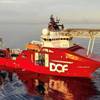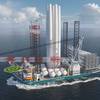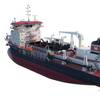Gladding-Hearn Delivers with Repeat, Proven Business in 2012
When the long-time operators of the National Park Service passenger route from Key West, Florida, to Dry Tortugas National Park were looking to keep that contract and further upgrade the quality of their offerings in that market, they did what most satisfied customers would do: they went back to the builder of their current vessel, Massachusetts-based Gladding-Hearn Shipbuilding. The original boat used by Yankee Fleet in this service, built in 1998, provided reliable service over the years, but new contract requirements and changes in certain regulatory regimes ultimately made its replacement necessary.
With the new Yankee Freedom III now in service, having been delivered in October of 2012, the Yankee Freedom II has been sold to a northeast operator and is currently undergoing modifications at – you guessed it – the Gladding-Hearn Shipyard in Somerset, MA. In addition to being repowered with new engines, the vessel will receive some internal refurbishment before continuing with its service life in New England.
Incat-Crowther Designed Yankee Freedom III
After inking a new 10-year contract with the National Park Service (NPS) for passenger service between Key West, Fla., and the Dry Tortugas National Park, Massachusetts-based Yankee Fleet ordered the new 250-passenger, high-speed catamaran to replace the ferry operator’s interim vessel, Yankee Freedom II. Although the newer, larger vessel, designed by Incat-Crowther, closely resembles the Yankee Freedom II in order to retain Yankee Fleet’s strong brand presence in this trade, the new hull boasts many improvements.
NPS requirements dictated that Yankee Freedom III provide a higher level of service and more seating options. The new contract requirements exceed that of the previous hull and the vessel design includes many of the “green” features required by the NPS, such as zero discharge, an oil boom on board, and energy-efficient LED lighting throughout the vessel. Additionally, a high-efficiency HVAC system augmented by the engines’ waste heat, solar-charged emergency batteries, metal-free bottom paint (Sherwin Williams SeaGuard), and a zero-VOC vinyl marine film applied to the exterior house instead of paint. The vinyl coating is lighter than paint and promises lower maintenance costs for the operator.
Special features: Lean, Green & Functionality
Gladding-Hearn immediately set about making the vessel greener, but also enhancing its long term viability. Of particular note was fitting of 2 Caterpillar 3512C engines that were sized to fit performance requirements, but also minimize fuel burn. There was no need for outsized, “too-large” engines, according to Gladding-Hearn President Peter Duclos. Nevertheless, top speed of the ferry is an impressive 28+ knots.
The LED lighting saves capacity on generators and the ferry is fitted with some solar panels. The multi-mission, catamaran vessel is also poised to respond to oil spills in the park, if necessary. Even the on board showers are fitted so as to collect gray water to protect the local environment.
Although the new vessel usually only carries 150 (limited by requirements of the Park Service), the vessel’s design capacity of 250 passengers allows for contingencies in the event of evacuations and/or special circumstances for those already on island camping, seasonal staff, etc. According to Duclos, the vessel complies fully with the new USCG passenger weight rules, which he says are primarily related to displacement issues. Nevertheless, the vessel also boasts an active ride control system (Vosper/MDI) which dampens movement at sea and provides more freeboard for the long offshore run (+60 miles). A large back deck area allows for plenty of room for camper’s gear and kayaks, etc.
Accommodations include 142 Beurteaux seats and 24 tables, a snack bar, and four heads in the main cabin. The upper cabin features a snack bar and seating and tables for 56 passengers, and an additional 54 exterior seats on the aft deck. The 120,000 Btu HVAC system heats and cools cabins and wheelhouse and interior sound levels are dampened to 70 decibels.
Ava Pearl - Rhode Island Fast Ferry
As it turns out, Yankee Fleet isn’t the only satisfied customer in the Gladding-Hearn portfolio to return to the fold in the past calendar year. That’s because Hull number 392, also delivered in 2012, was the M/V Ava Pearl, a 150 passenger, 34 meter excursion vessel which was added to the Rhode Island Fast Ferry fleet. Operating from Quonset Point, RI to Oak Bluffs, Martha’s Vineyard, the new vessel is specifically designed for improved economy during off-peak times, and complements the 400 passenger, 37 m Incat/Gladding-Hearn catamaran Millennium which has been operated by Rhode Island Fast Ferry for the past nine years. Delivery of the new vessel in July 2012 – also designed by Incat Crowther – allows Rhode Island Fast Ferry to service the same 52-mile route as the operator’s other Gladding-Hearn-built (1998) ferry, Millennium. Accommodating lighter passenger loads, with a lighter displacement, and driven by propellers, the new fleet addition results in significant fuel saving during off-peak times.
The all-aluminum catamaran draws seven feet (2m) draft and is powered by twin, continuously-rated MTU 12V4000M53 EPA Tier 2-approved diesel engines, each delivering 1851 Bhp at 1800 rpm and turning ZF Marine Ni-Br-Al propellers. The twin gearboxes will be ZF Marine model 5055 with “Super Shift” feature. The ferry is additionally equipped with two Cummins/Onan 55 kW generators.
Incorporating Incat Crowther’s proprietary “S” bow, the vessel provides excellent seakeeping, directional stability and high tolerance to shifts in trim and displacement. In addition, a large Naiad Dynamics active trim-tab ride-control system and higher freeboard further improve the ferry’s seakeeping ability and passenger comfort. Top speed is over 30 knots in moderate seas, with a deadweight of just 24 tons.
History: Reliability, Series Build & Loyalty, too
Founded in 1955 and well known on a regional basis, but not perhaps outside of its core markets, Gladding-Hearn Shipbuilding (a Duclos Corporation) has for more than 50 years built steel and aluminum commercial vessels. Located on the Taunton River in Somerset, Mass., the family-owned and operated shipyard counts almost 400 vessels built as proof of its longevity and vessel reliability. George Duclos, CEO and chairman, co-founded the yard with Pret Gladding and Richard Hearn, and eventually bought out his partners in 1983.
The domestic pilot boat market cannot be discussed without also mentioning that Gladding-Hearn has more launches operating in the United States than any other shipyard. Notably and after building pilot boats for more than two decades, the yard joined forces with designer C. Raymond Hunt Associates in 1978 to build the first launch with a deep-V hull, soon to become the industry standard. Today, Gladding-Hearn’s portfolio includes the construction of tugs, fire and patrol/rescue boats, research vessels, and by the mid-1980s, high-speed catamaran passenger ferries. As a licensee of designer Incat Crowther in Australia, Gladding-Hearn has since built the lion’s share of fast cats on the East Coast and the Great Lakes. Beyond this, and while Gladding-Hearn often uses other designs for their newbuild vessels, they also employ a full service, in-house design shop.
Referring to the Ava Pearl and Yankee Freedom III projects, Duclos told MarineNews in December, “These were real projects. No subsidies or grants were involved. Both made the economy grow and the buyers in both cases had to borrow and take risks.” No doubt that risk (and the anxiety that often goes with it in these uncertain times on the water) was considerably lessened simply by the knowledge that both buyers had already established a track record with Duclos’ Shipyard and that previous deliveries had performed well, exceeding expectations and were both still in the water.
U.S.-based, smaller shipbuilders are finding their niche in a competitive, but upbeat domestic market. That said; thin margins make for a complicated ‘bid and build’ environment. On this scale, the difference between success and failure can often be measured in simply in the quality of the last boat delivered. Proven quality, repeat business and competitive pricing – whether it comes in the pilot boat markets or for cutting edge designed ferries – are proving to be the key to Gladding-Hearn’s success. And, that’s not hard to understand, is it?
Yankee Freedom III on the Web: www.yankeefreedom.com
(As published in the January 2013 edition of Marine News - www.marinelink.com)











